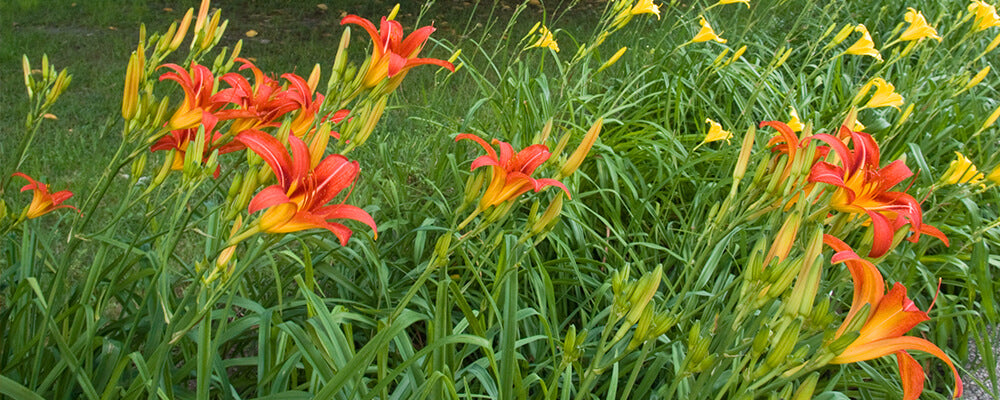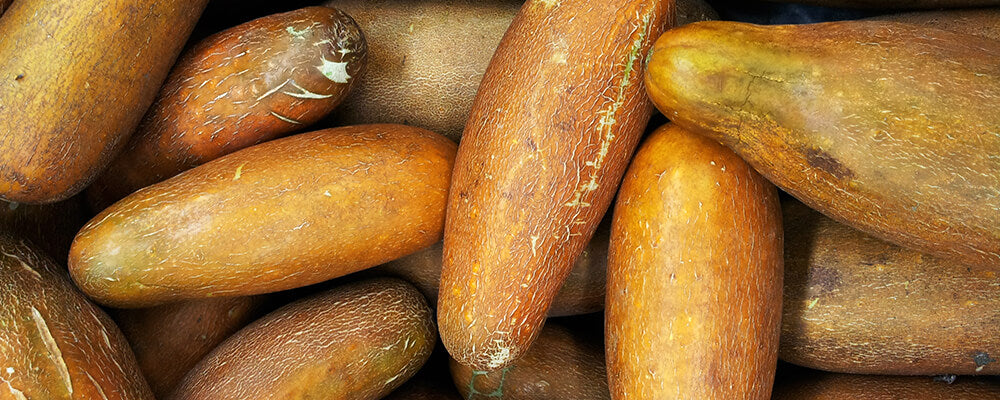Brent Answers More Questions from Social Media!
Posted by Brent & Becky's Admin on


Back in July, Jay and Brent answered your summer gardening questions on the Brent & Becky’s podcast, Tete-aTete. If you missed it, you can jump to a question below or press play to listen to the full episode!
Jump to a Question:
- I've dug up an overcrowded daffodil bed. How far apart should I put the ones I'm replanting?
- "Should I be doing anything with my wilted tulip leaves?
- "What causes daffodils to stop blooming?
- "Do I need to buy pre-cooled tulips to plant in zone eight?
- "Should I give up on or pull up bulbs if they don't bloom one year?
- "Is it the very hot weather that's killing my new plantings, even though I water faithfully?
- "How long is the average time for a tulip to stay in bloom?
- "Do Daylilies only last for a day?
- "What's going on in Brent’s garden these days?
Jay: Recorded live from the outskirts of beautiful downtown Gloucester, Virginia in the southwest corner of the second floor offices of Brent and Becky's, you are listening to Tete-aTete, a podcast by Brent and Becky about how you can get more bang from your gardening buck. I'm Jay Hutchins and sitting alongside of me somewhere between four feet and 4000 miles apart is Brent Heath. Together we hope to share with you how you can make the world more beautiful, one garden at a time. So let's get started right here on Tete-aTete. We are back. Greetings, everybody, and welcome to another edition of Tete-aTete. Today's date is July 22nd, 2020, middle of the pandemic.
Brent: Yeah, middle of the heat wave.
Jay: And a severe heat wave. Man, it's hot!
Brent: Yeah, but it's better than the shivering.
Jay: Well, that's true. I'll take this heat any day. Anyway, we are glad you guys have joined us for this latest episode. The theme for this one is asking your questions to us via social media. Let's get right to them. We are going to hop over to our Facebook page. Our first question is from Elizabeth. I've dug up an overcrowded daffodil bed. How far apart should I put the ones I'm replanting?

Brent: Almost all bulbs, that’s about three times the width of the bulb. Now, if they've divided significantly and there are a lot of little ones, give them about six inches apart with bigger daffodils to allow them room to grow and mature, because the small ones have probably stopped blooming because they are too crowded and have used up all the nutrients around them. So be sure to amend your soil with compost as well. Feed your soil.
Jay: Simple. Next question is from Katie. I have tulips planted at my house. They weren't planted by her, so I guess they came with the house.
Brent: Lucky girl.
Jay: The blooms come easily and very well in the spring. At this time of year, their foliage is done, pancakes to the ground, like a neighbor's fat cat took a nap on it, and they are all yellow. They get full easy facing in the sun. I've always just let them be, but should I be doing something more?
Brent: Not really necessary, but as soon as they begin to turn yellow, if they are unsightly, it's safe to go ahead and cut them off or pull them free from the bulb. The only thing about leaving the leaves, if they should get stressed and catch that fungus called Botrytis, which leaves little spots on the foliage that become necrotic and it rots, it is important to get rid of that. But aside from that, it's just fine to leave the leaves. They will go back to the soil, adding organic matter; so not necessary to take them away.
Jay: Thank you for the question. Moving on down the line to Kimberly next. What causes daffodils to stop blooming? I have great foliage, but no bud or blooms. Should I dig, divide and replant?
Brent: Several potential possibilities; daffodils are sun lovers, and if you did plant them in the shade, the leaves, the solar collectors are not gathering enough sunlight energy to photosynthesize to create enough starches and sugars to send back to the bulb, which is what supplies you with new blooms every year. The second is that in the shade, they just don't get enough. Second is, if you are fertilizing or your soil is very rich with nitrogen that causes a lot of blooms, a lot of leaves at the expense of blooms. So if there is too much nitrogen in the soil, you get a lot of leaves and not many blooms.
So digging and dividing, as soon as the foliage begins to turn yellow, that's the best time to dig and divide. Gently shake off the soil. Don't pull them apart if they are hard and visibly attached. You'll leave a scar and a chance for a fungus to get in and rot the bulb. You can hold them out of the summer, dry and warm and replant in the fall when soil temperatures cool or plant right away after you dig them. You have two options there; plant now, as soon as you dig them about six inches apart about typically six inches deep and or weight and plant them back in the fall, but keep them dry over this summer in a mesh bag with plenty of air circulation, not necessary to keep them cool.
Jay: Thanks for the question, Kimberly. We appreciate it. Next one up is from Patrick and he wants to know, do I need to buy pre-cooled tulips to plant in the Atlanta area? They are zone eight.

Brent: At Atlanta Botanic Garden, we do pre-cool their tulip bulbs, and I think they plant in November, but typically, I don't think it's absolutely necessary, but it's helpful. Pre-cooling is about starting off a little bit warmer, maybe 45 degrees and then lowering them down to about 35. Important to remember, you can't do it in a refrigerator with fruits and vegetables. The ethylene gas given off by ripening fruits and vegetables can cause the bulbs to abort their blooms. So you have to take the beer fridge and in the winter you don't drink cold beer anyhow. So you can simply put them in the beer fridge in the fall for pre-cooling. Typically 8 to 10 weeks of cooling and then you plant them in December or early January. Atlanta is one of those variable climates, also. In the past couple of years, we've had very warm winters. So probably you would have benefited to pre-cool your tulips.
Jay: I like a good cold beer anytime.
Brent: Oh, okay. Well I've been in Holland enough that they drink their beer room temperature. So I've kind of gotten used to it.
Jay: Patrick, thank you for your question. Moving onto the next one from Lo. Should I give up on or pull up bulbs if they don't bloom one year? I had beautiful gladiolus blooms last year, but none this year.
Brent: Wow. Okay. Typically again, if they are not getting enough light, they are not recharging the batteries, the voltage is not recharging. Also, keep your soil well fed. Feed your soil with good compost or good organic bulb fertilizer like Espoma bulb-tone- E-S-P-O-M-A, found at most good gardens centers and often at the box stores as well. Apply that in the early spring of your gladiola is to get down to the roots zone in time to do some good or during the late winter.
Gladiolus, also, we've had some questions about them in the past a week or so. Gladiolus come up and start blooming, but then begin to turn brown. In a hot summer, little insects that you don't see, called thrips-T-H-R-I-P-S, and thrips love gladiolus. To protect your gladiolus from the thrips, we suggest a dormant oil spray or neem oil, or even a diluted detergent, which will suffocate the little babies.
Jay: All right, Lo, thank you so much for your question. Moving on to the last question on Facebook and it's from Donna. Is it the very hot weather that's killing my new plantings, even though I water faithfully?
Brent: Oh, this is a... We kill plants with kindness sometimes. We tend to over water. Plants need air as well as moisture around their roots. Sometimes if we water every day or we give them too much water, particularly if your soil is heavy, you can fill up those airspaces with water and the roots actually drown. They will begin to turn yellow. Typically, most plants, except potted plants may need more moisture more frequently, but plants in the soil in the ground typically need moisture once or twice a week. Beyond that, probably over-watering is your problem.
Jay: That's what we thought, watering faithfully.
Brent: Yeah. And we kill them with kindness. We think, "Oh, our poor babies are so thirsty." It's a hard one, but you have to watch the plant a little bit. That's part of the fun game of gardening, is watching your plants. If it's wilting too much in the heat of the day and full sun, if they are in pots, move them to a little bit shadier location. But typically, some mulch around the plants is helpful to keep the water from evaporating too soon, but typically once or twice a week is enough.
Jay: There you go, Donna. Thank you so much for your question. We are going to hop over to Instagram where we only had one person ask a couple of questions.
Brent: Oh, good. Okay.
Jay: This person's name is Van.
Brent: Oh, hey, Van.
Jay: Who, if you don't know, is my son, his grandson. So he was contributing questions. One of them was, how long is the average time for a tulip to stay in bloom?
Brent: Oh, wow. That is pretty much totally dependent on the temperature during the day. The cooler it is when the tulip blooms, the longer they will last. And we've had some tools and some tulips... Not all are created equal. We've had some tulips last and bloom in a good spring, which is a long, cool spring. We've had some tulips last a month or more. Darwin hybrids in particular, tend to be longer lasting and flower. However, the good temperatures are maybe up to 70, but when you get to 80 and above, boy, they just wilt in the heat. They can't take it hot. They are actually from high mountain deserts where they bloom when it's relatively cool or cold in the spring, tulips are…. majority of tulips.
Jay: All right. And his second question, you can kind of understand this one. Do Daylilies only last for a day, hence the name?

Brent: The individual florets, because Daylilies have multiple florets and they come sequentially, and so one flower does last for about a day. However, I think some modern breeding has given us some Daylilies whose florets may last a day or two instead of just one day. But typically the one fades and becomes sort of squishy and soft, good time to pick it off and use it in a soup or something like that. It adds a mucilaginous quality and they are quite edible. The deer do love them. But typically you get one flower after another. Every day you get a new flower or multiples. Some Daylilies are now blooming and re-blooming. The Stella de Oro was one of the first real bloomers, but there are Happy Returns and there are Pardon Me, and there are a bunch of them that actually re-bloom in the spring and then again in the fall and sporadically throughout the summer.
Daylilies are amazing in the number of how long it takes to multiply from seed. One can let the insects make the crosses or one can make the crosses and harvest the seed and plant them and have them bloom, sometimes if you hold your tongue right within the first year after you planted the seed. So there are lots of Daylilies on the market all the time, brand new ones, but they are becoming pretty fancy flowers, some of them. Our favorite is VT Spirit, Virginia Tech Spirit, and bred by a friend, Linda Pinkham. It's pretty amazing because it has been in blooms since May and they are still in bloom right there in the field. It's a whoop de do hybrid. I can't remember all the technical terms, but it's something beyond a tetraploid, which is a doubling of the number of chromosomes bred back to another. It gives it that extra strength. It's really a super Daylily.
Before we stopped talking about Daylilies, you know, they've got some fun nicknames. There is nothing common about plants. We have to stop calling them common names. They all have proper names, which is Hemerocallis or Hemerocallis, I've been corrected on occasion, but in any event, some of the fun nicknames for them; they sometimes call them graveyard Ladies, because you do find them in... Or graveyard lilies because you do find them in graveyards frequently.
A lot of the heirlooms have been around for many years. They called them ditch lilies because they do seem to have... Some of the old fashioned ones do seem to have a preference for growing in ditches, but they also call them outhouse lilies because you often find them where there was an outhouse in the old days. We don't have outhouses as much anymore, but some of the early ones were quite fragrant. I think that kind of masks the aromas from the outhouse, but it kind of annoys the Hemerocallis growers when you referred to them as outhouse lilies.
Jay: Yeah, that one is not so appealing. Not so appealing. Well, thank you, Van. Appreciate your questions. I told him I would give him a plug. If any listeners have kids or grandkids that are into gaming like Minecraft or Fortnite, Van has his own YouTube channel at Vangenix. He's also on Instagram as VangenixYT and on Facebook as VangenixYT.
Brent: Wow. That's more things that I can't even think about.
Jay: So if you have kids that like it, you can go check him out. What's going on in your garden these days?
Brent: Well, I had to pick flowers this morning for an arrangement and boy, it was a little bit of a... It has been so hot. The flowers are not lasting as long in bloom when it’s so hot; just as I mentioned with the tulips earlier, but I did find some nice lilies. One of my favorite lilies of all time is called Black Beauty. She is not only one of the most perennial, they've been coming back for 20 years in my garden, but also one of the most floriferous and amazingly sweetly fragrant. But the fun part is, and if you do this with kids, look at the flower up close, and of course you want to emasculate it, take the anthers off so they don't stay in your clothing, but right in the keel, the center of each pebble there are little drops of moisture going in. Touch your finger to it, or to get a kid to touch their finger and then touch it to their tongue. It's super sweet just like honey. It's pretty amazing.
So I had Black Beauty lily. The other lilies are kind of fading. We are getting to the end of lily season. I did have a fun shrub that I picked some of. It's a die back shrub called Orange Crush. I've forgotten the proper botanical name. Cestrum, that's it, Cestrum. Ooh, wow. It took me a minute. The floppy disc just takes a little while to fall these days, but it's a great one because it blooms all summer long. You don't see it a lot commercially available, but I think it ought to be, because it dies back in the winter and then sends new shoots up in the spring, but it's long blooming and a lot of fun.
And then I've got a sunflower relative that's called Cup Plant or Silphium. It's a native. It's a big boy. It grows to six or eight feet tall, but has multiple sunflower-like flowers on it. It's said the birds use that cup... The cup will hold almost a whole cup of water where two leaves fuse together around the stem. The other fun thing about it is it has big square stems, but it's not a mint, like most other square stem plants. And then we use sunflowers as a cover crop over the daffodils and the sunflowers are just really coming into bloom today. It's amazing. We've had a dearth of rainfall, but last week we had six tenths of an inch and last night we had an inch and a quarter, which was awesome.
Jay: No kidding.
Brent: And everything is jumping now. The vegetable garden, the okra is coming in full swing. The green beans are great. The pole beans are great. Tomatoes are just beginning. Really those sweet little multi-colored tomatoes, cherry tomatoes are coming in. The peppers are coming in nicely. So it has been a fun gardening season; a lot of squash and cucumbers. People can't get over the brown cucumbers that I have this year. They are called Russian Brown cucumbers. They start off white and then they gradually turn yellow and then they are brown. But when they are brown, they are very tasty. I think there are different flavors and different vegetables and it may be my imagination, but I think these cucumbers have a little bit of a nutty flavor to them, really quite good.

Jay: Interesting and white on the inside, just brown on the outside?
Brent: That's correct. Yeah.
Jay: Interesting. All right. Well, Brent, thank you so much for your time. Stay cool out there.
Brent: People say, why do you wear long sleeve shirts and long pants when it's so hot? You ought to be wearing shorts. Well, I wear clothing that wicks moisture. So I sweat. Sweating is good for you. It gets my clothing wet, and as it evaporates, I stay cooler. I don't mind it. I do go in for lunch. I tend to do most of my playing... and I play in my garden. I don't work there. I do most of it early in the morning. All of us gardeners get up real early. Well, I'm up before the sun comes up and I do most of the harder stuff when it's cooler in the morning. And then as it cools off in the afternoon, I do some more, but I enjoy my garden. I'm having a great time.
Jay: That's great.
Brent: So play in your gardens, have fun, share what you do with other people. It's amazing the positive impact that your fruits and vegetables and flowers will have on other people.
Jay: That's the truth. Thank you very much.
Brent: Thank you.
Jay: And thank you for joining us on this latest edition of Tete-aTete. You can subscribe to this program by going to Talkshoe.com or podcasts on iTunes and searching Brent and Becky's. Follow us on Facebook, Instagram, Twitter, wherever you are social. Again, just search for Brent and Becky's on those platforms. We will let you know when we will be recording another episode. You can leave your questions there and we will answer them on the next show. Thanks again for joining us. Let's get out there and make the world more beautiful. We will see you next time on Tete-aTete.
Share this post
- Tags: blooming, brent, Brent and Becky's, brent and becky's blog, bulb, bulbs, daffodil, daffodils, expert advice, fall planting, flowers, garden, gardening, gardening tips, grow, interview, planting, planting bulbs, plants, podcast, questions, tulips



